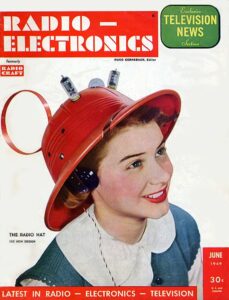
In the late 1940s, an era brimming with optimism and the promise of new technology, a peculiar invention briefly captured the public’s imagination: the Radio Hat. This quirky, ahead-of-its-time device was more than just a gadget; it was a symbol of post-war innovation and a peek into a future where technology and everyday life would become increasingly intertwined. The story of the Radio Hat isn’t just about an unusual fashion statement; it’s about ambition, the pursuit of novelty, and the fleeting nature of some inventions.
The Radio Hat made its debut in 1949, introduced by American inventor Victor Hoeflich. At a time when portable radios were still relatively bulky and cumbersome, Hoeflich’s invention stood out for its unique integration of technology and personal accessory. The hat, which came in various colors, had a built-in radio complete with an antenna and batteries concealed within its structure. Users could listen to their favorite radio stations via earphones that connected to the hat, turning the simple act of wearing a hat into a personal entertainment experience.
Imagine the scene: people walking down the street, each tuned into their own world of music and news, a personal soundtrack to their day-to-day life. The Radio Hat was more than just a way to listen to the radio; it was a statement, a piece of wearable technology that signaled a futuristic vision where fashion and function could merge. It promised a new level of personal freedom and convenience, a way to bring your entertainment wherever you went, a novel concept in the days before smartphones and earbuds.
However, the Radio Hat’s journey was as brief as it was bright. While it initially generated interest and curiosity, the practicality of the design soon came into question. The hat was somewhat bulky, with its protruding antenna and the weight of the batteries and radio components. It was a far cry from the sleek, unobtrusive technology we’re accustomed to today. Fashion, too, played a role in its decline. What was initially a novelty soon became seen as a bit too eccentric for everyday wear, a gadget that was perhaps too ahead of its time.
Moreover, the rapidly evolving technology of the era quickly outpaced the Radio Hat. Portable radios continued to shrink in size and increase in efficiency, making them more convenient to carry and use without the need for integration into clothing. The novelty of the Radio Hat couldn’t compete with the practicality and growing affordability of these handheld devices.
Despite its short-lived popularity, the Radio Hat’s legacy endures as a fascinating footnote in the history of technology and fashion. It was a precursor to the wearable technology that would become prevalent in the 21st century, an early experiment in combining utility with personal style. The Radio Hat reminds us that the path of innovation is filled with trials and errors, with ideas that may seem outlandish at first but pave the way for future advancements.
Today, as we don our smartwatches and wireless earbuds, it’s worth looking back at the Radio Hat with a sense of whimsy and appreciation. It represents a time of boundless creativity and optimism, a belief in the power of technology to enhance our daily lives in ways previously unimaginable. The Radio Hat, in its own quirky way, was a harbinger of a world where technology is an intimate, ever-present part of our personal landscape.
The story of the Radio Hat is more than just the tale of a forgotten gadget; it’s a narrative about the spirit of innovation, the fleeting nature of fashion, and the eternal human quest for progress. It’s a reminder that even the most unconventional ideas have a place in the journey of invention, contributing to the rich tapestry of our technological history and inspiring future generations to think outside the box. As we tune into our own devices and navigate a world filled with technology, the Radio Hat stands as a symbol of the wonder and possibility that defines our ongoing relationship with the inventions that shape our lives.